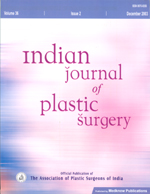
|
Indian Journal of Plastic Surgery
Medknow Publications on behalf of Indian Journal of Plastic Surgery
ISSN: 0970-0358
EISSN: 0970-0358
Vol. 40, No. 2, 2007, pp. 182-188
|
 Bioline Code: pl07052
Bioline Code: pl07052
Full paper language: English
Document type: Research Article
Document available free of charge
|
|
|
Indian Journal of Plastic Surgery, Vol. 40, No. 2, 2007, pp. 182-188
| en |
What is the best choice for repair of distal penile hypospadias: The tubularized incised plate urethroplasty or anterior urethral advancement technique?
Awad, Mohamed M.S.; Tolba, Adel M.; Saad, Khaled M.; Zaghlol, Mahmoud R.; Rozigque, Ahmed Ezzat; Gharib, Osama H. & Khalil, Saalim A.
Abstract
Background and Aim: Numerous ingenious methods have been introduced to repair hypospadias with variable results. We tried to evaluate the two techniques, tubularized incised plate urethroplasty (TIP) and anterior urethral advancement (AUA) for repair of distal hypospadias and choose the best method to treat the distal type of penile hypospadias with the least complications.
Materials and Methods : A total of 140 boys with distal penile hypospadias were divided into two groups. Group A (68 patients) was treated with TIP and Group B (72 patients) was treated with AUA. All the patients had an average age of three years (2-19) with variable meatal sites coronal (44) sub coronal (53) and anterior penile hypospadias (43). There was no significant difference between both groups with respect to the age and meatal sites.
Results: The fistula rate in Group A was 8.8% versus 1.3% in Group B. There was no urethral stricture in both procedures. Wound dehiscence did not occur in Group A versus one case in Group B (1.3%). In Group A, 26 cases (38.3%) had mild glanular torsion and five (7.3%) had moderate glanular torsion versus none in Group B postoperatively. No postoperative chordee or binding in Group A, versus four patients (5.5%) in Group B. No significant difference was observed in both groups with respect to meatal stenosis (7.3% versus 5.5% respectively). There was a significant difference between both groups with regard to the operative time in favour of Group B. Good cosmetic appearance of the glans was achieved in both techniques.
Conclusion: Both techniques can treat this anomaly with a high success rate but the modified AUA technique appears to be a good choice due to its simplicity, short operative time and less fistula rate with good cosmetic results.
Keywords
Advancement, choice, hypospadias, urethra
|
| |
© Copyright 2007 Indian Journal of Plastic Surgery.
Alternative site location: http://www.ijps.org/
|
|
